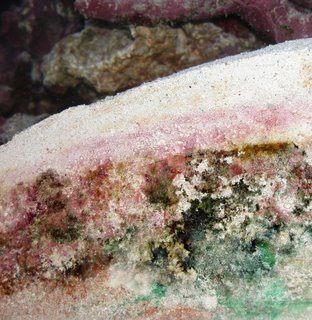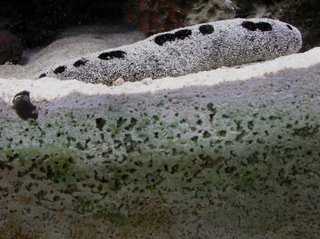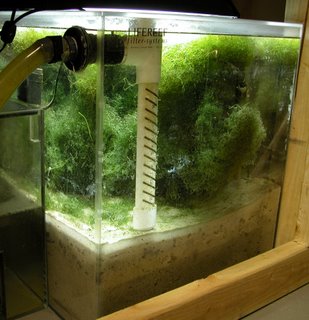 Hiro Sushi's Six Inch Sand Bed.
Hiro Sushi's Six Inch Sand Bed. There has been a lot of discussions lately on the bulletin boards I frequent about whether aquarium's should be set up with a deep sand bed, shallow bed or bare bottom. I have always been a huge advocate of using as deep a sand bed as aesthetically possible, using Carib Sea AragaMax sugar sized sand. In addition to a deep sand bed, I also use a refugium, live rock, high flow in the water column, a protein skimmer and calcium reactor in reef tanks. This equipment and the proper stocking of animals make a fool proof system.
 Java Sushi's Five Inch Sand Bed.
Java Sushi's Five Inch Sand Bed. Installation of a deep sand bed is one of the least expensive type of filtration, and requires minimal maintenance when paired with the proper animals to do the work. The Pacific Black Sea Cucumber is an excellent sand sifting animal that does not destroy a sand bed of life. In addition, the Orange Diamond Goby, large Nassarius Sand Snails and burrowing bristle and spaghetti worms help remove sediment. They are actively consuming diatoms and promotes oxygen penetration that allows them to live in the bed.
 LifeReef Refugium.
LifeReef Refugium. A deep sand bed occupies a large amount of viewing space in an aquarium. I prefer to use a minimum of a three inch sand bed in an aquarium and then a 6-8 inch sand bed in an auxiliary refugium. This LifeReef 40 gallon refugium with chaetomorpha algae has an 8 inch sand bed that keeps nitrates undetectable in a 180 gallon heavily stocked reef tank. I also employ the use of Leng Sy's EcoSystem Refugiums in some of the smaller systems I maintain.
 Hiro Sushi's Six Inch Sand Bed. There has been a lot of discussions lately on the bulletin boards I frequent about whether aquarium's should be set up with a deep sand bed, shallow bed or bare bottom. I have always been a huge advocate of using as deep a sand bed as aesthetically possible, using Carib Sea AragaMax sugar sized sand. In addition to a deep sand bed, I also use a refugium, live rock, high flow in the water column, a protein skimmer and calcium reactor in reef tanks. This equipment and the proper stocking of animals make a fool proof system.
Hiro Sushi's Six Inch Sand Bed. There has been a lot of discussions lately on the bulletin boards I frequent about whether aquarium's should be set up with a deep sand bed, shallow bed or bare bottom. I have always been a huge advocate of using as deep a sand bed as aesthetically possible, using Carib Sea AragaMax sugar sized sand. In addition to a deep sand bed, I also use a refugium, live rock, high flow in the water column, a protein skimmer and calcium reactor in reef tanks. This equipment and the proper stocking of animals make a fool proof system.  Java Sushi's Five Inch Sand Bed. Installation of a deep sand bed is one of the least expensive type of filtration, and requires minimal maintenance when paired with the proper animals to do the work. The Pacific Black Sea Cucumber is an excellent sand sifting animal that does not destroy a sand bed of life. In addition, the Orange Diamond Goby, large Nassarius Sand Snails and burrowing bristle and spaghetti worms help remove sediment. They are actively consuming diatoms and promotes oxygen penetration that allows them to live in the bed.
Java Sushi's Five Inch Sand Bed. Installation of a deep sand bed is one of the least expensive type of filtration, and requires minimal maintenance when paired with the proper animals to do the work. The Pacific Black Sea Cucumber is an excellent sand sifting animal that does not destroy a sand bed of life. In addition, the Orange Diamond Goby, large Nassarius Sand Snails and burrowing bristle and spaghetti worms help remove sediment. They are actively consuming diatoms and promotes oxygen penetration that allows them to live in the bed. LifeReef Refugium. A deep sand bed occupies a large amount of viewing space in an aquarium. I prefer to use a minimum of a three inch sand bed in an aquarium and then a 6-8 inch sand bed in an auxiliary refugium. This LifeReef 40 gallon refugium with chaetomorpha algae has an 8 inch sand bed that keeps nitrates undetectable in a 180 gallon heavily stocked reef tank. I also employ the use of Leng Sy's EcoSystem Refugiums in some of the smaller systems I maintain.
LifeReef Refugium. A deep sand bed occupies a large amount of viewing space in an aquarium. I prefer to use a minimum of a three inch sand bed in an aquarium and then a 6-8 inch sand bed in an auxiliary refugium. This LifeReef 40 gallon refugium with chaetomorpha algae has an 8 inch sand bed that keeps nitrates undetectable in a 180 gallon heavily stocked reef tank. I also employ the use of Leng Sy's EcoSystem Refugiums in some of the smaller systems I maintain.
No comments:
Post a Comment